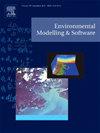基于分步时空多元并行化的大尺度水文模拟
IF 4.8
2区 环境科学与生态学
Q1 COMPUTER SCIENCE, INTERDISCIPLINARY APPLICATIONS
引用次数: 0
摘要
分布式水文建模的进步要求更高的时间和空间分辨率,增加了对高性能计算的需求。径流路由模型由于上下游依赖关系而面临效率低下的问题。增加线程减少了计算时间,但由于任务不平衡而降低了效率。提出了一种基于OpenMP的分步时空多元域分解方法。该方法应用于珠江流域90 m分辨率,在寨高(110808格)、石角(494万格)和奥斯特0(4858万格)3个站点进行了测试。结果表明,对于10年的每日模拟(总共3653个时间步),传统串行计算分别需要172.18、7726.94和79,470.21秒。使用13个线程时,空间分层并行化将时间减少到21.86、757.93和7262.06秒,实现了0.61、0.78和0.84的效率。在ZhaiGao上,52个线程仅使用空间分层时的效率为0.06,但在添加时间索引和多成员并行化后,效率分别提高到0.55和0.80。总的来说,我们的方法显著加快了大规模水动力洪水建模。本文章由计算机程序翻译,如有差异,请以英文原文为准。
Accelerating large-scale hydrological modeling with stepwise spatial-temporal multimember parallelization
Advancements in distributed hydrological modeling require higher temporal and spatial resolutions, increasing the demand for high-performance computing. Runoff-routing models face inefficiencies due to upstream–downstream dependencies. Increasing threads reduce computing time but lower efficiency due to task imbalances. We propose a stepwise spatial–temporal–multimember domain decomposition method with OpenMP. Applied to the Pearl River Basin at 90-m resolution, the method was tested at three stations: ZhaiGao (110,808 grids), ShiJiao (4.94 million grids), and Outlet0 (48.58 million grids). Results showed traditional serial computing took 172.18, 7726.94, and 79,470.21 seconds, respectively, for 10-year daily simulations (totaling 3653 time steps). With 13 threads, spatial layering parallelization reduced times to 21.86, 757.93, and 7262.06 seconds, achieving efficiencies of 0.61, 0.78, and 0.84. At ZhaiGao, 52 threads yielded efficiency of 0.06 with only spatial layering but increased to 0.55 and 0.80 upon adding temporal indexing and multimember parallelization. Overall, our approach significantly accelerates large-scale hydrodynamic flood modeling.
求助全文
通过发布文献求助,成功后即可免费获取论文全文。
去求助
来源期刊

Environmental Modelling & Software
工程技术-工程:环境
CiteScore
9.30
自引率
8.20%
发文量
241
审稿时长
60 days
期刊介绍:
Environmental Modelling & Software publishes contributions, in the form of research articles, reviews and short communications, on recent advances in environmental modelling and/or software. The aim is to improve our capacity to represent, understand, predict or manage the behaviour of environmental systems at all practical scales, and to communicate those improvements to a wide scientific and professional audience.
 求助内容:
求助内容: 应助结果提醒方式:
应助结果提醒方式:


